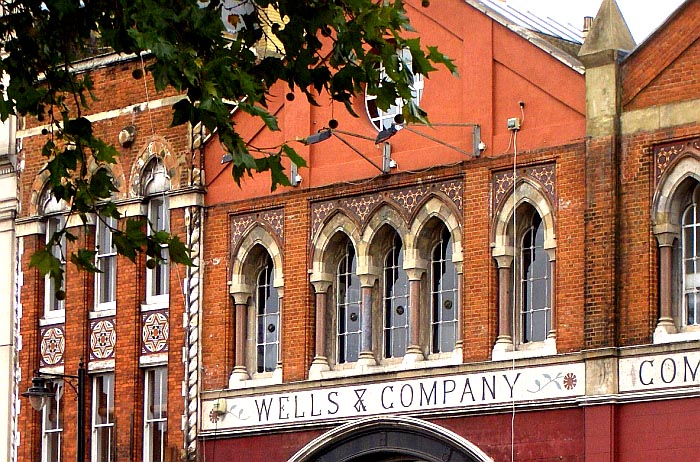
Window detail of the former Wells and Co foundry and showroom, Shoreditch. Listed Building. Designed by J. W. Brooker, c.1877-80. 125-30 Shoreditch High Street, London EC 1. Photograph, caption, and commentary below by Jacqueline Banerjee. [You may use these images without prior permission for any scholarly or educational purpose as long as you (1) credit the photographer and (2) link your document to this URL in a web document or cite the Victorian Web in a print one.]
In the London borough of Hackney's list of "listed buildings," the old Wells & Co. premises on Shoreditch High Street are described as Italian Gothic in style, with "cusped pointed window arches and mosaic inlaid stars of David at third floor level." Wells & Co. were cabinet ironmongers and this was their purpose-built foundry and showroom. An inscription in the centre (not visible here) reads, "Contractors to HM Dockyards, Metropolitan Board of Works, Corporation of London School Board." The architect is not named, but this company built other premises nearby, one of which is described in an amendment to the list as having been designed by J. W. Brooker. This building too is described as having "Gothic, Italianate and Venetian elements." It seems fair to assume that the company used Brooker for both.
It is interesting to see that Ruskin's influence had penetrated the East End, and almost certain that he would have disapproved: he came to hate the way that "partial use" of his views had "dignified our banks and drapers' shops with Venetian tracery" (qtd. in Clark 193). But the decorative frontage is perfectly understandable here, because Shoreditch was a centre of the furniture industry, and the showrooms would have been built to advertise craftsmanship.
Philip Webb had been at work in the neighbourhood as well, designing a row of workshops with accommodation above them at 91-101 Worship Street (1862). These were built at the bidding of the philanthropist Colonel William Gillum: they have very high-pitched tiled roofs, and dormers, and even incorporate a carriage arch and a Gothic stone-and-marble drinking fountain. London's East End, with its artisans and its philanthropic input, is full of interesting architecture.
Sources
Clark, Kenneth. The Gothic Revival. Harmondsworth: Penguin (Pelican), 1964.
"Hackney: Listed Buildings S" — scroll down for 125-30 Shoreditch High Street; see "W" for Webb's 91-101 Worship Street.Viewed 9 December 2007.
"Hackney Walks."Viewed 9 December 2007.
"102nd Amendment [to the Listed Buildings List]."Viewed 9 December 2007.
Owen, Kay. "A General History of Shoreditch and South Hoxton."Viewed 9 December 2007.
Last modified 29 September 2012.